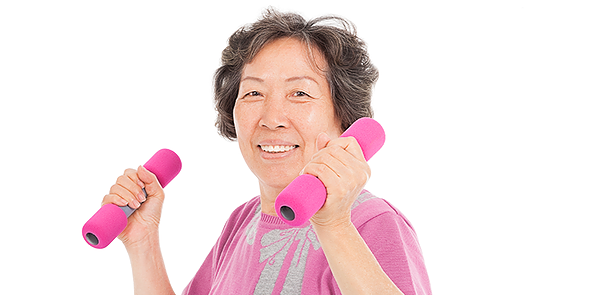Exercise as you get older
Physical activity and exercise can help you stay healthy, energetic and independent as you get older.
Many adults aged 65 and over spend, on average, 10 hours or more each day sitting or lying down, making them the most sedentary age group.
They’re paying a high price for their inactivity, with higher rates of falls, obesity, heart disease and early death compared with the general population.
As you get older, it becomes even more important to remain active if you want to stay healthy and maintain your independence.
If you do not stay active, all the things you’ve always enjoyed doing and taken for granted may start to become that little bit harder.
You may struggle to pursue simple pleasures, such as playing with the grandchildren, walking to the shops, leisure activities and meeting up with friends.
You might start to get aches and pains you never had before and have less energy to go out. You may also be more vulnerable to falling.
This can all lead to being less able to look after yourself and do the things you enjoy.
Strong evidence
There’s strong evidence that people who are active have a lower risk of heart disease, stroke, type 2 diabetes, some cancers, depression and dementia.
If you want to stay pain-free, reduce your risk of mental illness, and be able to go out and stay independent well into old age, you’re advised to keep moving.
Recent evidence suggests that regular exercise can reduce the risk of falling in older adults.
It’s that simple. There are lots of ways you can get active, and it’s not just about exercising.
Most people as they get older want to stay in touch with society – their community, friends and neighbours – and being active can ensure they keep doing that.
What is physical activity?
Physical activity is anything that gets your body moving. It includes anything from walking and gardening to recreational sport.
Aim for at least 150 minutes of moderate activity every week.
Ideally, you should try to do something every day, preferably in bouts of 10 minutes of activity or more.
One way of achieving 150 minutes of activity is to do 30 minutes on at least 5 days a week.
Examples of moderate-intensity aerobic activities include:
- walking fast
- water aerobics
- riding a bike on level ground or with few hills
- playing doubles tennis
- pushing a lawn mower
Daily chores like shopping, cooking or housework do not count towards your 150 minutes because the effort is not hard enough to raise your heart rate, although they do help break up sedentary time.
In addition to your 150-minutes target, try to do some activities that work your muscles.
This can include:
- weight training
- carrying heavy loads
- heavy gardening
As well as regular physical activity, try to reduce the amount of time you spend sitting down during the day.
This means avoiding long periods of TV viewing, computer use, driving, or sitting to read, talk or listen to music.
Getting started
What you do will depend on your own circumstances but, as a guiding principle, it’s a good idea to do activities you enjoy.
If you’re already active, you may find it useful to know that 75 minutes of vigorous activity over a week is as beneficial as 150 minutes of moderate activity.
Research shows it’s never too late to adopt and reap the health benefits from a more active lifestyle.
For example, older adults who are active will reduce their risk of heart disease and stroke to a similar level as younger people who are active.
If you’ve been inactive for a while, you can gradually build up your activity to reach recommended levels. You’ll still be improving your health in the process, and you’ll reduce your risk of falls and other ailments.
The biggest benefits come to those who start from scratch. It’s moving from a sedentary lifestyle to a moderately active one that makes the biggest difference to your health. The more you do, the greater the health benefits
Learn More
For more information about physical activity, nutrition, and health, the following sources may be helpful.
- Physical activity and your health. Government of Canada. https://www.canada.ca/en/public-health/services/being-active/physical-activity-your-health.html
- Canadian Physical Activity Guidelines. http://www.csep.ca/CMFiles/Guidelines/CSEP_PAGuidelines_adults_en.pdfn.pdf)
- Healthy Eating. Heart and Stroke Foundation of Canada. https://www.heartandstroke.ca/get-healthy/healthy-eating
- Healthy Weight. Heart and Stroke Foundation of Canada. https://www.heartandstroke.ca/get-healthy/healthy-weight
- Healthy Kids. Heart and Stroke Foundation of Canada. https://www.heartandstroke.ca/get-healthy/healthy-kids
- Canada Food Guidelines (updated 2019). https://food-guide.canada.ca/en/
Note:
The contents on Avail such as text, graphics, images, and information is not intended to be a substitute for professional medical advice, diagnosis, or treatment. Always seek the advice of your physician or other qualified health provider with any questions you may have regarding a medical condition. Never disregard professional medical advice or delay in seeking it because of something you have read on this or any other website.













